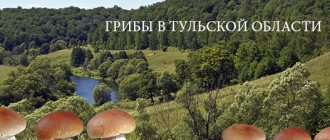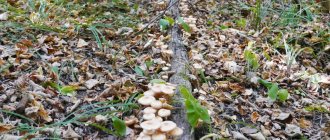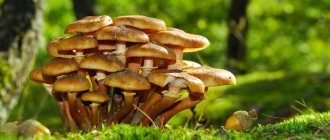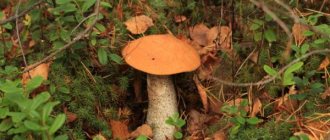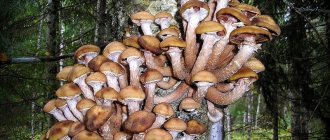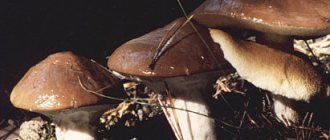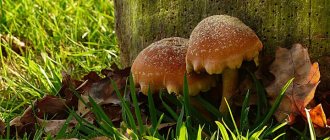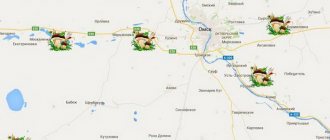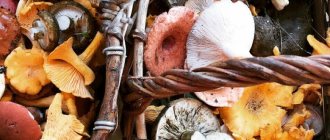Expert opinion
Gennady Sergeevich Rylov
A great expert in mycology and an avid mushroom picker. Knows everything about mushrooms, their types and places of growth
Residents of the outskirts of Pskov have long known, since the time of the wise Princess Olga, the value of the gifts of the forest, including mushrooms, which are good in stews, fried, dried or pickled. Avid mushroom pickers create real “mushroom maps” and even forums dedicated to “silent hunting”, without fear of being ahead of faster or luckier rivals. Here you can get acquainted not only with the list of “mushroom places” and the roads leading to them, but also learn how not to get lost in the forest. And most importantly, which “gifts of nature” should be put in the basket, and which ones should be left to grow where they grew.
The best “mushroom places” in the Pskov region
As soon as the “harvest” time arrives, mushroom pickers of the Pskov region go:
- to the Izborsk region, a native of which, according to the legends, was Princess Olga, who wisely ruled her forest possessions;
- towards Gdov, where boletus mushrooms are found in abundance, preferring “clean” dry forests;
- in the vicinity of the Riga Highway, where it is convenient to reach both by public transport and by your own car;
- to the village with the poetic name Nightingales, where saffron milk caps and other mushrooms grow, ideal for autumn pickling.
Flag of Pskov region
Poisonous mushrooms in the Pskov region
Of the inedible mushrooms, only the toadstool is deadly poisonous. It is easy to confuse it with russula or champignon. Distinctive features of the toadstool: a greenish cap, a “lace skirt” on the leg, white, sometimes with green, plates, white flesh at the break. Symptoms of poisoning - severe, cramping, abdominal pain, frequent diarrhea, continuous vomiting, thirst, headache, weakness, cold sweat - appear 8-12 hours after the meal.
Fly agaric is also a threat to inexperienced mushroom pickers. This mushroom is not always as in the picture - red and white. The cap can be brownish, grayish, greenish. One and a half to two hours after consumption, nausea, vomiting, sweating and weakness, as well as impaired consciousness are guaranteed. Morels and strings seem to be edible, but it’s better not to take risks. They contain poison - helvella acid, which is harmful to the spleen.
Mushroom "calendar"
The collection season in these parts is relatively short - it lasts only five months a year, because in April the snow barely melts in the local forests.
| Month | May | June | July | August | September |
| Types of edible mushrooms: | Appetizing, but requiring special culinary skills, morels and early boletuses. | Boletuses, still rare chanterelles, long-awaited early honey mushrooms, wild mushrooms, boletus, which just begs to be added to the frying pan. | The most abundant month, when you can find porcini mushrooms, tasty chanterelles, russula and honey mushrooms ready for pickling in abundance. | Summer continues - we collect porcini mushrooms, boletuses with attractively bright caps, always attractive chanterelles, and tight milk mushrooms. | The end of the “quiet hunt”, but in the forests there are still late honey mushrooms, delicious saffron milk caps, russula that require careful preparation, and other species for autumn pickling. |
What mushrooms and where to collect them
For mushrooms, you should go along the Gdov highway towards Yamm. At the 75th kilometer, turn left through the pioneer camps. There is a pine forest there, in good years there are a lot of porcini mushrooms. “And it’s just nice to pick mushrooms there,” says Evgeniy Noskov. – No matter how many times I traveled with friends, they were always surprised that the forest was absolutely clean, there were no dead trees, you just went into a pine forest and picked mushrooms. They weren’t even afraid for the children, that they would get lost or get lost.
A good place along the Gdovskoe highway, 55th kilometer (from the city of Pskov, of course), on the left and right there is also a good pine forest, where there are also mainly porcini mushrooms. – But there are now a lot of mushroom pickers in this direction from St. Petersburg. In the direction of the village of Krivsk across the Obdekh River - turn to Pechory, road to Novy Izborsk, cross the bridge of the Obdekh River and turn to the right. The pine forest runs along the railway to the Baltic States. – The forest is confusing, it’s easy to get lost there, as there are many similar roads. If you came out in one place, it was as if you had already passed through here. But in fact, you go out, and there is another road. So you need to be very careful.
Towards Solovyov, along the Leningradskoye Highway, in front of Solovyov, turn left. There are a lot of mushrooms, they are different, but the forest area there is small. But sometimes you can find more mushrooms in a small forest than in a huge one. Good to collect along roads. First you go one way, then you come back. – I like this most of all: because you get lost less, and the mushroom yield is not bad. Mushroom spots – in the direction of the 41st kilometer along the Riga Highway. But in those places there are more deciduous trees, and you come across milk mushrooms, white milk mushrooms, and saffron milk caps.
From Novy Izborsk, along the railway, you can drive towards Pechory, to the Vashina Mountain area. There is a lot of oil in the town of Ivanovo Boloto towards the village of Krupp. Turn left into the forest and there are these same boletus.
What are they collecting?
According to regional and local professionals - the head of a large base with 30 years of experience and a private picker with 15 years of experience - chanterelles and blueberries are now in great demand. Recently, porcini mushrooms have come into play.
Strawberries, although a tasty, aromatic and terribly healthy berry, are not pleased with their volume, are difficult to assemble and have a short life cycle, so there are few people who want to pick them, and their season in our region has already passed. Lingonberries, raspberries, blackberries, one might say, are also in business, but they are not very popular.
In almost every corner of our region you can find a reception point. It is no secret that residents of the Pskov outback earn money to survive for the whole year during the mushroom and berry picking season. And city dwellers are not averse to earning extra money.
Basically, the collection scheme is as follows: villagers and simple enthusiasts collect different amounts of food (some three kilograms, others ten) and hand them over to the local receiver. Almost every settlement has active residents who are ready for this work and can pay a pretty penny for the work. As a last resort, suppliers send a small van and organize the reception themselves. This happens about once every two days. The resulting “harvest” is packaged and sold to a larger dealer. The requirements for pickers are simple and understandable to everyone: cleanliness and integrity of berries and mushrooms. Mushrooms with uncut stems, covered with moss and needles, will not be accepted from you, no matter how many you bring. Berries must be without leaves. An interesting point is that during the rainy season the reception points are not open. This is due to the safety and weight of the product. If it rained for three days and you decided to cut some money easy to celebrate, don’t flatter yourself. Mushrooms containing moisture weigh more and deteriorate faster; therefore, they will not survive long-term storage and transportation. The pickers wait until the goods dry out and only then shell out cash for them. More natural weight and more chances to deliver a quality product to the consumer.
Mushroom dishes
Potatoes stewed with mushrooms
Ingredients: 1 kilogram of potatoes (preferably ones that boil well); 400 grams of mushrooms (boletus, boletus, boletus, boletus, to choose from); 1 medium carrot; 1 medium onion; 1 tbsp. spoon of tomato paste or 3-4 tbsp. spoons of tomato sauce; water; sunflower oil; salt; ground black pepper; Bay leaf
Solyanka mushroom
Potatoes stewed with mushrooms
Fried honey mushrooms
Mushroom julienne
Mushroom soup
Salted milk mushroom salad
Tourist Song Festival
Every year, for 18 years, a music festival has been held on the territory of Silver Lake, which brings together bards and tourists not only from Russia, but also from neighboring countries. It is known that since 2012 the event has acquired the level of an All-Russian festival.
The celebration usually takes place at the end of July and lasts for 3 days. The festival begins with a creative rehearsal around the fire with performances by singer-songwriters.
On the second day, guests will enjoy orienteering competitions and training races in canoes and kayaks. In the evening of the same day, on the shore of the lake there is a concert of original songs of clubs in Pskov, the region, as well as representatives of their other regions of the Russian Federation. The festival of art songs and poetry ends with a festive concert, where all participants receive diplomas and memorable gifts.
© Ilya Shalapanov
Ecological situation
The disadvantages of the lake also include the regular accumulation of garbage on the shore and in the forest near the attraction. There are abandoned barbecues and piles of coal from fires all around.
Apparently, vacationers do not bother themselves much to bring pieces of paper, bottles and other waste to a specially organized garbage collection site. But on the territory of Silver Lake there are garbage containers for this purpose.
As you know, cleanup days are regularly held on the territory of the lake with the support of the Pskov Region State Committee for Nature Management and Environmental Protection as part of the “Clean Shores” campaign. The event is organized jointly with volunteers.
© Alexander Smirnov
Activists are fighting the current situation by regularly holding environmental actions. They clean the territory of Silver Lake and the surrounding area from emerging garbage. The water protection zones of lakes such as Karetnoye, Zerkalnoye and Zhukovo (all of which belong to the Gdovsky district) are also being cleaned.
As a rule, cleaning of the above-mentioned reservoirs and surrounding areas is carried out over a period of 5 months - from June to October inclusive. During this time, the organizers carry out about 12 trips, in which 50 people take part. Everyone is provided with equipment, a hot lunch, and transportation to and from the cleaning site. During the event period, approximately 200 cubic meters are exported. m. of garbage.
After environmental campaigns are carried out in the cleaned areas, volunteers place stands with social advertising calling on vacationers to maintain cleanliness and order in the area.
Panorama of Silver Lake on Google Map
A “silent hunt” for chanterelles and boletuses began in the forests of the Pskov region
Mushroom season is in full swing. The first wave of whites has already passed, and now more chanterelles and boletuses are being found in the forests. Alexandra Vekua went on a quiet hunt with an experienced mushroom picker.
Boris Lapupin has known the local forest since childhood. At first I went mushroom hunting for fun, but now nature helps me relax. At home, the pensioner fries, stews, pickles, pickles the gifts of the forest, and makes a mixture from chanterelles to strengthen the immune system.
“We dry it at a low temperature of 60 degrees and grind it. We grind it here and there, it becomes like flour and we drink it with some water,” says Boris Lapupin.
His grandson Roman Alferyev goes on quiet hunts with Boris. Despite his young age, the student will give odds to any avid mushroom picker. The main principle is to collect only familiar and non-wormy mushrooms. For days on end, fans of quiet hunting trample kilometers of forest paths. And all for the sake of such a valuable reward.
“You see, there are chanterelles again.” ABOUT! Three little white ones. We also take the white ones. Of course. Strange - together with chanterelles.
Along with white ones, the top popular ones include boletus, honey mushrooms and saffron milk caps - we didn’t see them. Boris says the pine forest is too dry for such mushrooms. But we collected two buckets of chanterelles.
“It happened twice, I don’t know what it’s like further down in the Zhelchi area, there seemed to be little white ones being dragged around. Were. But this growth, or layer in scientific terms, as they say, is very fast, fleeting. Purely in a pine forest, not in a pine forest, you won’t find anything. The moss is cracking,” Boris Lapupin, resident of the Gdovsky district.
But there are a lot of blueberries and lingonberries in the pine forest. Local berries are collected eagerly. They make jam, tinctures, and treat relatives.
“Today I picked blueberries with my grandmother. Grandfather drives a car, looking for places for us where there are a lot of blueberries. Then he brings it there. You need to look for places where there is a lot of it,” shares Roman Alferyev.
Toadstools are also found in the forest, some look like edible mushrooms. Often, according to locals, the health of novice mushroom pickers is undermined by false russula, honey mushrooms and boletus.
“Edible mushrooms can also be harmful to health if picked at the wrong time and in the wrong place. For example, this porcini mushroom is already too old and it contains toxins. Also, you can’t pick mushrooms near the highway, they accumulate heavy metals,” Alexandra Vekua, correspondent.
You should also approach cooking with caution. The collected trophies must be carefully sorted, washed, cleaned and cooked on the same day.
- Only I told you that there are no white ones, here I cut the chanterelles, here you go behind a tree, and he, the beauty, is standing!
Residents of the Pskov region boast about their successes in silent hunting on social networks. Some people carry buckets of white ones home, while others collect chanterelles and aspen boletuses. The number of mushrooms and their diversity depends on the area and precipitation. Experienced mushroom pickers say that a rich harvest in the forest can be harvested in warm weather after prolonged rains.
Alexandra Vekua, Vladimir Shagapov
Who needs it?
According to the heads of large collection bases, there are two main corridors for the sale of forest products - restaurants and factories. We were assured that Pskov catering establishments, whose menus include berries in one way or another, are provided with products collected in their native land.
“The trucks are mostly sent abroad. This is, as a rule, Germany, Poland, Finland. They are ready to accept everything,” said a large wholesaler of forest raw materials, adding that many foreigners are ready to create branches in our country and arrange supplies to their native lands. We must pay tribute to our compatriots, they are giving a worthy rebuff. The final stop for mushrooms and berries is easy to guess. Yogurts, jams, lemonades, preserves - everything you see on the shelves most likely comes from Russia. It is worth noting that there is practically no waste in this craft. Products that for some reason cannot be sent for sale (defects during transportation or poor presentation) are dried and turned into compote and other products. All this is either sold at budget prices or sent to charity.
From all that has been said, we can draw an unambiguous conclusion: the field of collecting wild crops is large-scale and continues to grow. Every year the demand increases, and with it the competition increases. This is hard work, and for many, the only source of income. There is no place for lazy people and contemplators. By the standards of one person, mountains of gold are not expected, but as for industrial volumes, everything is much more interesting. Foreigners won't let you lie.
It is a pleasant thought that our land supplies vitamins and environmental resources to millions of people. The thought is pleasant, but the situation is serious. Everything we borrow from nature will sooner or later have to be repaid. This is worth remembering - and taking exactly as much as our conscience can carry. Everything grows under your feet, and by raising your head, you can enjoy the beautiful views (there is no point in reminding about fresh air). We can only hope that all this will provide a new point of growth for residents and the region as a whole. Nature does everything on time, we need to keep up.
Nikita Cherkashin.
Nikita Cherkashin
How to dry mushrooms in the forest
Drying mushrooms in field conditions is not an easy task, but it can be done. Porcini mushrooms, boletus mushrooms, boletus mushrooms, fly mushrooms and young boletus mushrooms are suitable for this. You can also dry chanterelles and autumn mushrooms. Try to collect young mushrooms that are hard to the touch, avoid soft and large caps that contain a lot of moisture, as well as rough mushroom stems. Choose a place in a well-ventilated and sunny clearing. Pre-light a fire using thick logs to obtain a large amount of coals.
Dig a shallow hole under the fire and, if there are stones nearby, place them in the fire to retain the heat longer. Then clean the mushrooms from debris and rot, while cutting and laying them on bunches of dried last year's grass or tree branches. for pre-drying.
Gather the coals into the center of the fire. Stick 4 slingshots made of tree branches on its sides and place longitudinal rods on them. Collect bundles of mushroom slices strung on a strong thread and tie them at the required distance to these rods. Instead of threads, you can use branches or splinters. Mushrooms should not stick to each other. Periodically turn the bundles over the heat. Place the dried mushrooms in a glass jar or cloth bag.
You can dry mushrooms directly in the sun and wind by stringing them onto branches or splinters and placing them vertically in a sunny, ventilated place. A properly dried mushroom should break when pressed lightly and give in slightly when you press on its surface.
